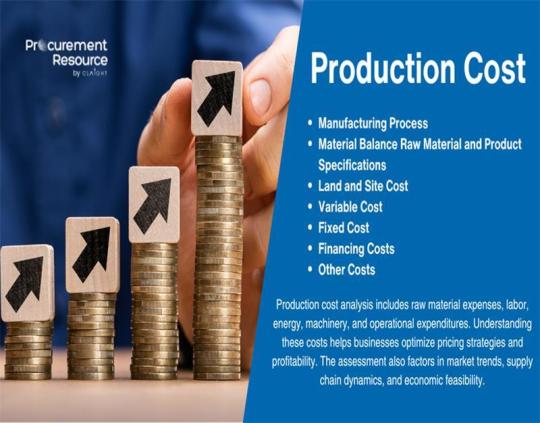#RegionalCostTrends
Explore tagged Tumblr posts
Text
Production Cost Insights for Mirtazapine (Remeron) With Trend Analysis

Mirtazapine, commonly marketed under the brand name Remeron, is a widely prescribed antidepressant used primarily to treat major depressive disorder (MDD). As global mental health awareness and treatment access increase, the demand for Mirtazapine continues to rise. For pharmaceutical companies, manufacturers, investors, and procurement professionals, understanding the Mirtazapine (Remeron) Production Cost is essential to making informed decisions regarding sourcing, manufacturing, pricing, and investment planning.
This article explores the key cost components involved in producing Mirtazapine, including raw materials, utilities, labor, logistics, and supply chain dynamics, while also presenting valuable insights into market trends, the manufacturing process, and cost analysis models.
Mirtazapine (Remeron) Production Cost Analysis Report
A comprehensive Mirtazapine (Remeron) Production Cost Analysis Report offers an in-depth look at the key financial elements driving the production of this drug. These include:
Cost Model Structure: Involves fixed and variable cost elements such as raw materials, utilities, labor, depreciation of machinery, and compliance costs.
Pre-Feasibility Study: Evaluates the technical and economic feasibility of Mirtazapine production for new entrants or existing players looking to expand operations.
Production Cost Processes: Includes unit operations like chemical synthesis, crystallization, purification, and packaging that contribute to the final cost per unit.
Analyzing these cost drivers helps stakeholders navigate the complex dynamics of the pharmaceutical industry with clarity and confidence.
Raw Materials and Manufacturing Process
The production process of Mirtazapine involves a series of chemical reactions and purification steps. It typically begins with the preparation of intermediate compounds derived from precursor chemicals such as methyl 2-chloronicotinate and substituted piperazines.
Raw Material Costs form the backbone of total production expenses and fluctuate based on global chemical supply trends, geopolitical developments, and currency exchange rates. Other components like solvents, reagents, and catalysts also contribute to overall material costs.
The multi-step synthesis is followed by purification through crystallization or chromatography, and final formulation for tablet production. These steps demand stringent quality control and regulatory compliance, influencing the cost structure significantly.
Procurement professionals rely on Procurement Resource to track raw material availability, market rates, and lead times, ensuring uninterrupted production and optimized inventory management.
Utilities, Labor, and Industrial Trends
Utilities such as electricity, water, and steam play a pivotal role in the Mirtazapine manufacturing process. The pharmaceutical industry often operates under high energy requirements due to heating, ventilation, air conditioning (HVAC), and controlled environments.
Utility Costs: Vary significantly by geography and production scale, depending on energy prices and government tariffs.
Labor Charges: Skilled labor is required for formulation chemistry, quality assurance, machine operations, and packaging. Labor costs depend on location, workforce availability, and skillset.
Recent industrial trends in pharmaceutical manufacturing include automation, the use of AI in formulation development, and energy-efficient production practices. These innovations aim to reduce operational costs while ensuring product consistency and regulatory adherence.
By leveraging data-driven insights from sources like Procurement Resource, companies stay ahead in adapting to evolving trends and reducing production overheads.
Logistics and Supply Chain Overview
An efficient logistics and supply chain system is essential for the uninterrupted production and distribution of Mirtazapine. The pharmaceutical supply chain involves multiple stakeholders: raw material suppliers, manufacturers, contract research organizations (CROs), wholesalers, and retailers.
Inbound Logistics: Deals with timely delivery of APIs (Active Pharmaceutical Ingredients), excipients, and packaging materials.
Outbound Logistics: Ensures timely transportation of finished formulations to distributors and end-users.
Storage and Warehousing: Requires strict climate control, particularly for sensitive pharmaceutical ingredients and formulations.
The rising trend of just-in-time inventory management and regional warehousing is helping companies manage fluctuations in demand while reducing storage costs. Procurement Resource assists in supply chain optimization through comprehensive data on supplier networks, transport options, and risk mitigation strategies.
Regional Manufacturing and Market Dynamics
The production cost of Mirtazapine varies based on regional manufacturing dynamics.
North America: Has well-established pharmaceutical infrastructure but faces high labor and compliance costs.
Asia-Pacific: Countries like India and China offer competitive production advantages due to low labor costs and large-scale API manufacturing hubs.
Europe: Operates under strict regulatory frameworks which increase operational costs but ensure high product quality and safety standards.
Understanding these regional cost differentials is crucial for businesses considering outsourcing or setting up manufacturing operations in new territories.
Mirtazapine Product Details and Applications
Mirtazapine is a tetracyclic antidepressant that enhances the central noradrenergic and serotonergic activity.
Product Applications include:
Treatment of major depressive disorder (MDD)
Management of anxiety and sleep disorders
Off-label uses in PTSD and obsessive-compulsive disorders
Its demand in both generic and branded form is rising as mental health awareness improves globally.
From formulation design to packaging and branding, production economics must balance efficacy, affordability, and compliance.
Pre-Feasibility and Cost Optimization
Before scaling production, pharmaceutical companies often rely on pre-feasibility studies to determine investment viability. These studies assess:
Land and infrastructure requirements
Regulatory landscape and compliance costs
Access to utilities and skilled labor
Expected ROI based on production volume and cost-per-unit estimates
Procurement Resource assists clients in conducting accurate feasibility analysis by integrating cost data, supply chain logistics, and industry benchmarks. This empowers firms to optimize operations and reduce production bottlenecks.
Request a Free Sample
To gain a clearer understanding of the Mirtazapine (Remeron) Production Cost, you can now request a free sample report that includes:
Cost structure breakdown
Raw material pricing trends
Process flow diagrams
Regional cost benchmarks
Industrial feasibility insights
Request a Free Sample-https://www.procurementresource.com/production-cost-report-store/mirtazapine-remeron/request-sample
This complimentary sample provides valuable insights for R&D teams, business developers, and procurement managers aiming to make data-backed strategic decisions.
Contact Information
Company Name: Procurement Resource Contact Person: Ashish Sharma (Sales Representative) Email: [email protected] Location: 30 North Gould Street, Sheridan, WY 82801, USA
Phone Numbers: UK: +44 7537171117 USA: +1 307 363 1045 Asia-Pacific (APAC): +91 1203185500
Connect With Us Online:
Twitter (X) LinkedIn Pinterest YouTube Website
#MirtazapineProductionCost#RemeronManufacturing#APIcostAnalysis#PharmaCAPEX#CostPerKgAPI#GreenChemistry#SustainablePharma#BiocatalysisAPI#Industry40Pharma#AIinDrugMaking#MirtazapineIndia#GenericMirtazapinePricings#APIpriceComparison#RegionalCostTrends#RemeronVsGenerics
0 notes